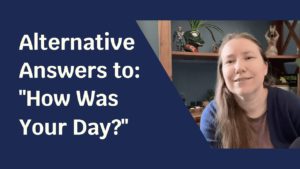
Alternative Answers to: “How Was Your Day?”
For some people, asking “How Was Your Day?” is a low stress way to start a conversation, so I’d like to talk about some low stress ways to respond.
Is one of your intentions for the new year to work on your anxieties?
In this 4 week course, you’ll learn a framework and several practical techniques to reduce the impact of anxiety on your day to day life, that actually work for our Autistic brains.
From an Autistic/ADHD human who has been through the anxiety minefield.

Hi there, Heather with Autism Chrysalis here, just a quick note to let you know that I’m putting on a four week course in February on how to reduce anxiety in your life, from an autistic and neurodivergent perspective.
We’ll be going over several autistic-friendly tools to reduce immediate overwhelm.
How to find the underlying painful thoughts that are making your real life circumstances feel even worse.
How to begin to dismantle those painful thoughts.
And put all that into practice in the real life circumstances you’re struggling with.
All the details are at autismchrysalis.com/anxiety, and the link is in the first comment as well. Have a neurowonderful day.
What happens when you think about…
If you’re like I was just a few years ago (and many of my clients are), even thinking about these gets dangerously close to overwhelm, shutdown, or an urge to rant. Does your stomach clench or your throat tighten? Or do you get snippy with people? Or hide (that cabin in the woods would be so nice…sigh)?
What if you had skills to deal with these thoughts when they come up? I won’t promise they will go away forever (let’s be realistic), but I firmly believe (and have experienced) that it is possible to learn how to diffuse them so that they aren’t as intense.
And when they’re not as intense, they’re not as overwhelming.
So your brain will have capacity left over to think other things, like finding useful solutions to those situations.
People have accused you of procrastinating, being a perfectionist, overthinking, or being lazy, or you’ve accused yourself of these things (they’re all untrue by the way), and while yes, okay, you aren’t taking action, its not for the reasons people assume.
The trouble is, you have a history of genuinely bad experiences with situations like these and you’re trying to avoid all the potential pitfalls, or else don’t have a clue how to avoid the very real dangers, and it’s so easy to focus on those, and everything else that genuinely could go wrong.
And even when you intellectually know that most of those worries probably won’t happen this time, it’s not so easy to turn off the scenes of disaster playing on endless loop in your head, or the clenching in your gut, or to fall asleep with your mind on overdrive.
Talking yourself out of fretting doesn’t work.
Forcing yourself to do things only works for a while, then the resistance grows stronger.
Trying harder is crap. You’ve tried with every ounce of your being. There isn’t any energy left.
Tips for procrastination don’t work, because it’s not really that.
Overthinking isn’t combatted by thinking your way out (if only!) or just thinking less (hah!).
Reframing anxieties doesn’t get at the real issue when you have so many real experiences of what you’re anxious about coming true.
And allistics just don’t get it.
Overthinking isn’t combatted by thinking your way out (if only!) or just thinking less (hah!).
What if, instead, you could figure out what parts are the real world pain and what parts are made worse by how you’re thinking about it, and could toggle between those?
What if you had skills to diffuse these painful thoughts when they come up? I won’t promise they will go away forever (let’s be realistic), but it is possible to learn how to reduce their intensity.
And when they’re not as intense, they’re not as overwhelming.
So your brain will have capacity left over to think other things, and find genuine solutions to those real problems.
That’s when anti-anxiety techniques and tricks are most helpful, to deal with the leftover anxiety enough that you can put into practice the solutions you’ve planned.
As you do, and experience neutral or positive results, over time that will rewire your nervous system to trust that you have new skills and abilities to deal with hard things.
As you deal with more hard things, and learn more skills, and your nervous system trusts you more and more, the anxieties will gradually fade.
Although worries and fears may always come up, they won’t be paralyzing anymore. Because you can deal with them.
Because you can deal with them.
Although worries and fears may always come up, they won’t be paralyzing anymore. Because you can deal with them.
I know this, because I’ve lived it.
You see, I’m Autistic and ADHD, and struggled with anxiety (and depression) for decades.
At times it was so intense that I barely left my house for months or years at a time. The phone taunted me. Having one thing planned in a day (week) meant the whole day (week) was shot. I canceled at the last minute so often that I lost friends, and endangered relationships with others. Work took all my energy and thoughts, until it sapped my strength so I couldn’t work at all.
The mental framework and practical techniques in this course weren’t the only things that brought me out of that, but they were an important part of the mix, and I continue to use them on a daily basis to get through many small and large parts of life.
Now I share them with my coaching clients, with neurodiverse teens, and am excited to share them with you.
I’ve taught a teen version this class 18 times, to over 130 neurodivergent teenagers, with 100% 5-star reviews – 17 of them!
But that was only available to teens. People kept asking me to modify it for adults, so that’s what I’ve done!
I offered the first round of this to Autistic and ND adults in November 2023, and got very positive feedback!
I’ve tweaked a few things to make it even better, and now you get the benefit of that this time around.
Check out some of those reviews from the first adult cohort and from parents of less anxious teens, below.
This will redirect you to the course platform, Sutra.co.


What anxiety is and isn’t:
a little brain science.
Technique 1: “Heart Circling,” a mildly calming experience of physical compassion, to start the class.
The theory: Clean Pain vs. Dirty Pain. Noticing the distinction between absolutely real things that bring us pain and the thoughts that make the pain much worse.
Technique 2, putting theory into practice: “I’m having the thought…”, in which I notice that what I’m thinking is just a thought.
Q&A: Applying this to your life.

Technique 1: “Name your story,” in which we title a cluster of painful thoughts like a story, to refer back to later like a work of fiction.
The theory: The 4 Categories of Human Experience. How to separate the real pain from painful thoughts, and common pitfalls.
Technique 2, putting theory into practice: “The Observer,” in which we watch our worrying self and create an imaginary safe space for those worries to live.
Q&A: Applying this to your life.

Technique 1, “Sensory Anchoring,” in which nearby neutral objects keep us in the present moment, away from the painful parts of the past and anxieties about the future.
The theory: More tips on how to find that painful thought.
Technique 2, putting theory into practice: “A Variety of Vocalizations,” in which we playfully take some of the pain out of that tired old thought by laughing at how silly it can sound.
Q&A: Applying this to your life.

Technique 1: “Open Focus,” a way to drop down into a grounded state by readjusting our focus.
The theory: Curiosity as an antidote to anxiety.
Technique 2, putting theory into practice: “Getting Curious”, in which we question painful thoughts without judgment, in a search for the truth.
Recap: putting all the parts together in real scenarios.
Q&A: Applying this to your life.
There are 8 practical techniques built into the course, but I often throw in a few others here and there, depending on people’s questions, so you’ll probably end up with more than promised. 😉
They’re not all going to appeal to you. It’s neither a personal failure nor a flaw in the curriculum if they don’t all work for you.
I’m trying to provide a wide enough variety so that at least one or two will resonate with you.
If even one or two are helpful, and you use them even inconsistently, it can make a big difference over time.
If even one or two are helpful, and you use them even inconsistently, it can make a big difference over time.
Each meeting will start with a physical anti-anxiety technique, to help soothe our nervous systems so our brains can work better for the rest of the class.
Then we’ll get into some theory, and a technique to directly put that theory into practice.
I’ll answer questions as we go, so you don’t have to hold them to the end. To the extent that you want to share, I want to help you apply this to your specific situation.
We’ll have a little time at the end for any last Q&A.
The total cost is $180 USD.
This can be paid in one payment or two monthly payments.
Yes!
If it’s a choice between this and something essential (like food, heat, rent, childcare, etc.), but otherwise you’re ready and wanting to take full advantage of this course, I’m happy to offer you a scholarship.
I’ll be subsidizing a full scholarship for every five full pay participants, and there’s an option for generous participants to add a bit to their course fee, so there may enough funds for several partial scholarships.
To get one, send me a short email (sample script below to copy/paste).
You don’t need to explain why, defend your need, or flog your poverty. Just tell me how much you can afford, and if I can accommodate that, I will.
Sample email script:
Hi Heather, I’d like to take advantage of your offer of a scholarship. I’m able to contribute $x USD toward the course. Will that work for you?
Thanks,
Name
I’ll respond with a link to sign up if I can meet your request (which is likely; I’m a softie at heart).
Hopefully this will be more streamlined next time I do a group course. I’m still figuring things out.
I’m so glad you’re able and willing to help others!
Yes, there is a pay-it-forward option, and every dollar will go directly to scholarships for others in this course.
I been thinking a lot about that, because I would love to make everything I make available to all regardless of anyone’s current financial state. Because I’ve been in the position of having little to nothing to spare and yet really needing help.
There are several competing dynamics here, creating lots of conflicting tensions.
There’s a lot of talk in business spaces around charging high prices as if that were equivalent to personal worth or how much I value myself.
And a lot of talk in accessibility spaces around charging little to nothing to make it affordable for all.
There’s also pressure as a female presenting human to give away my labor as “caring for the community.”
And there’s the additional pressure from my own painful history with money and capitalism, as someone who has lived in poverty and is used to scrounging for mere survival, which created an unhealthy relationship with money and charging anything, especially when I know many of my clients are also struggling. And my nervous system is still recovering from that.
Those pressures are all coming from ideologies that fetishize either high or low prices.
But none of them is grounded in what it actually takes to make my business sustainable so that I can do this work for a long time (not a short burst of great content followed by burnout), and create a future in which we all are able to benefit from our labor and skills.
To establish a healthy relationship with money and economic justice, I also need to be a recipient of economic justice. I need to earn enough that I can keep my housing, food, (extensive) medical costs, support my family, pay my assistant a fair wage (another element of economic justice), pay the vendors that provide the platform for this course and the other services I use, etc.
(By the way, as part of my economic justice strategy, whenever possible I choose software and services from smaller companies, minority owners, B-corps, etc. who pay and treat their employees well.)
So what does it cost for me to sustain the work I do?
I’ve actually done the math, and based upon what it takes to put on this course, divided by the number of people I can reasonably expect to sign up, it takes $180/person.
Asking for compensation is violating a lot of cultural conditioning. It’s taboo. But a system that expects marginalized groups to consistently provide uncompensated or undercompensated labor is not economic justice.
Economic justice is when all parties receive fair value. You get anti-anxiety strategies that can influence your life (including income-generating potential) for the better, and I get money that I can turn into the things I need to live.
The price I’m asking for is simply what it takes for me to cover the time, labor, and expenses it takes to put on this course and provide this service to you. That’s a fair price.
If you give the course a fair shot and don’t find at least one technique, tool, framework, or idea that’s worth $180 to you over the course of your life, I’ll refund your money with no arguing or nastiness. I want you to feel this was worth it.
If you change your mind before the course starts, you’re welcome to a refund minus $20 for credit card processing fees.
The live course lasts 4 weeks, but you can access the recordings and all the other content for at least a full year (longer if I renew my subscription to Sutra, the platform the course is hosted on).
This will redirect you to the course platform, Sutra.co.
You’re getting a revamped and upgraded adult version, but this will give you an idea of my ability to deliver on my claims.
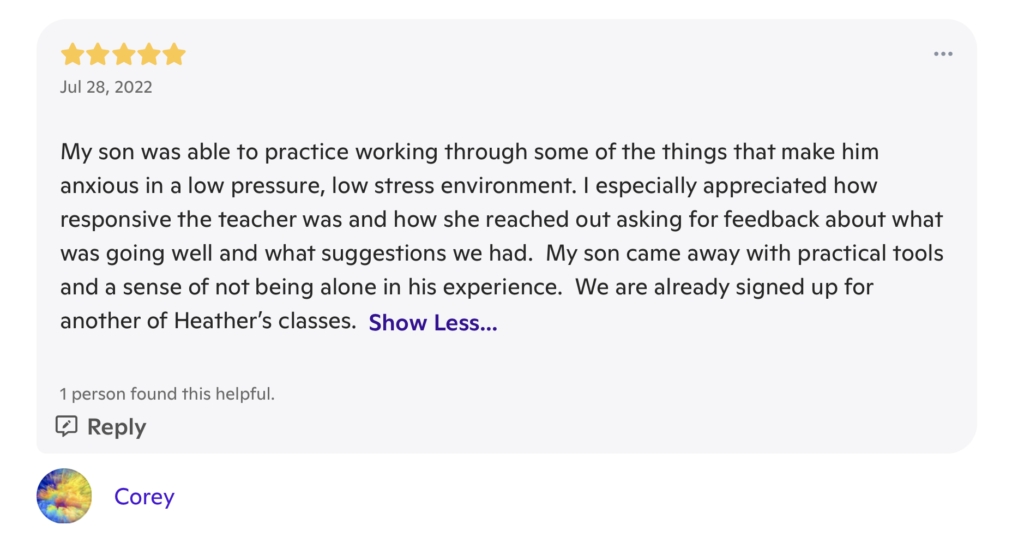
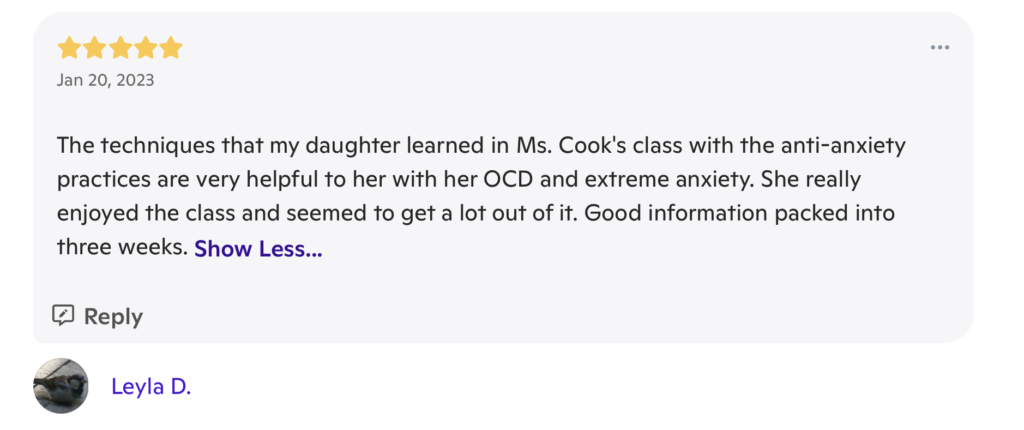
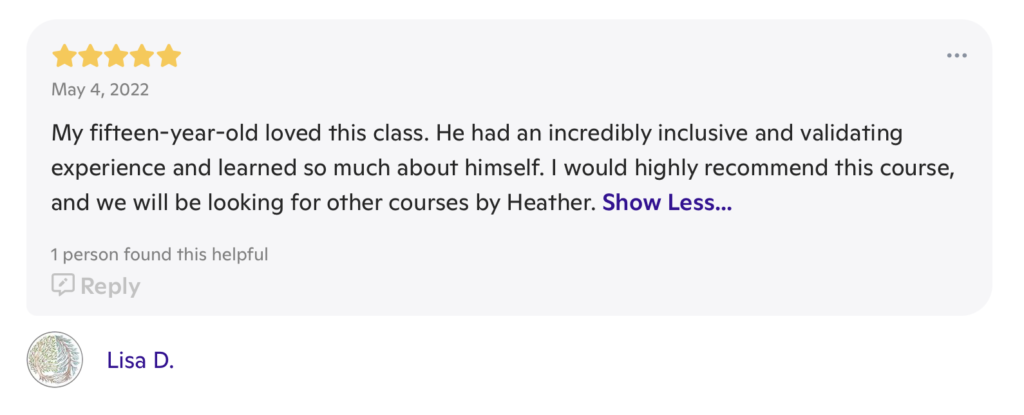
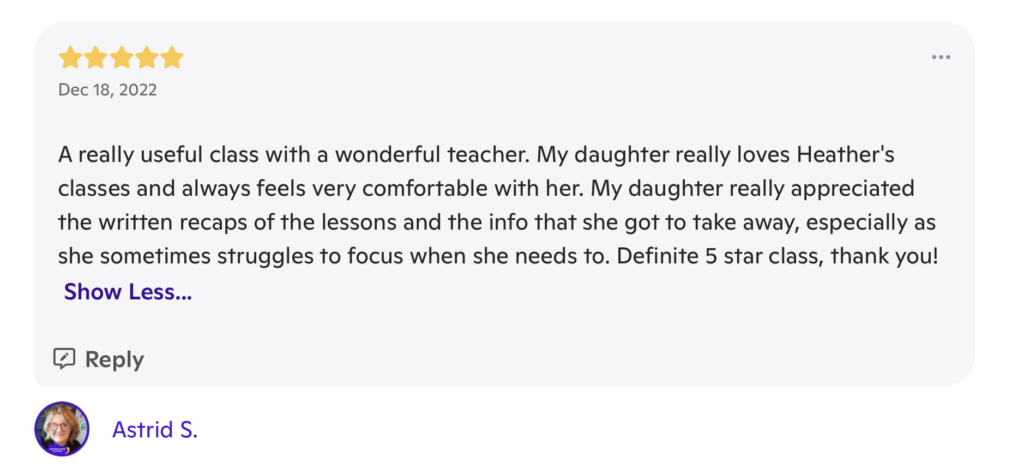
Live meetings take place on Saturdays:
February 3, 10, 17, and 24, 2024
9-10:30 AM PST – 12-1:30 PM EST – 5 PM-6:30 PM GMT
No problem. You’re welcome to treat this as an asynchronous/self-pased/on-demand course with no judgment from me. (I get it. Sometimes I don’t want to do live meetings, either.)
The recordings and all the rest will be available the day after the live meetings. The transcripts sometimes take two days, because a human goes through the whole thing to correct machine mistakes.
You’ll get:
Video recordings, audio recording download, transcripts, and chat logs of every meeting. Along with PDFs of the slides and all handouts, and any other bonus content I add.
This will redirect you to the course platform, Sutra.co.
You’re getting a revamped and upgraded adult version, but this will give you an idea of my ability to deliver on my claims.
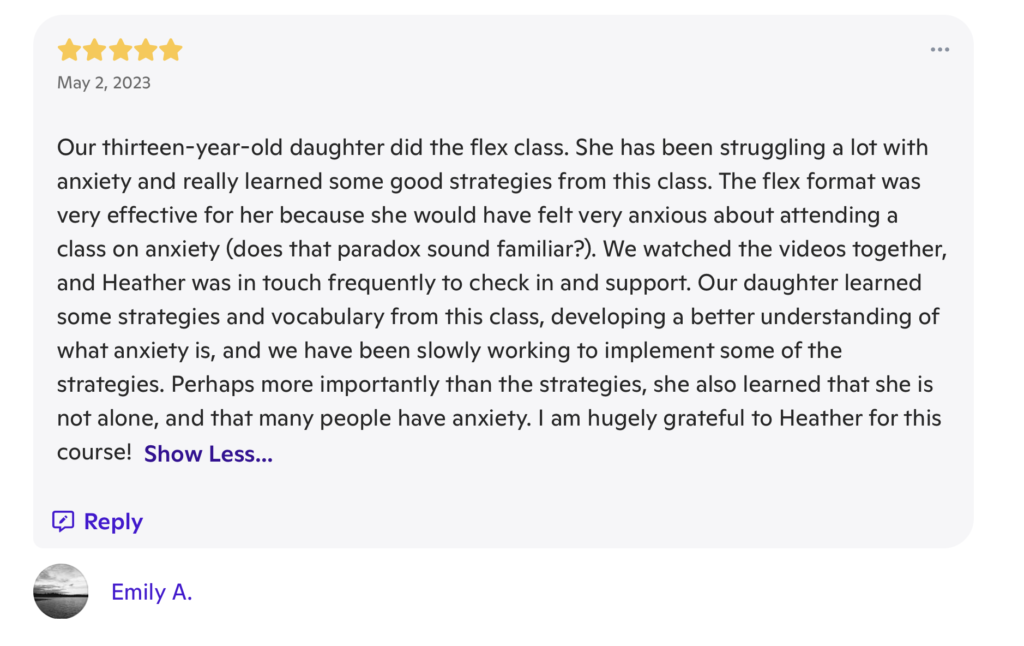
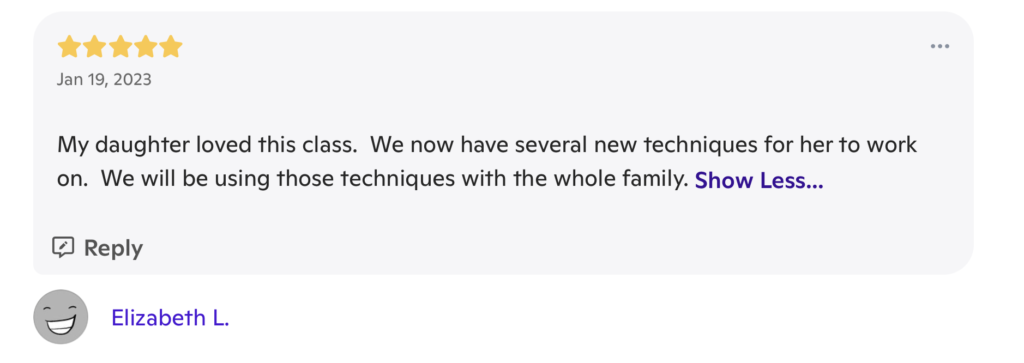
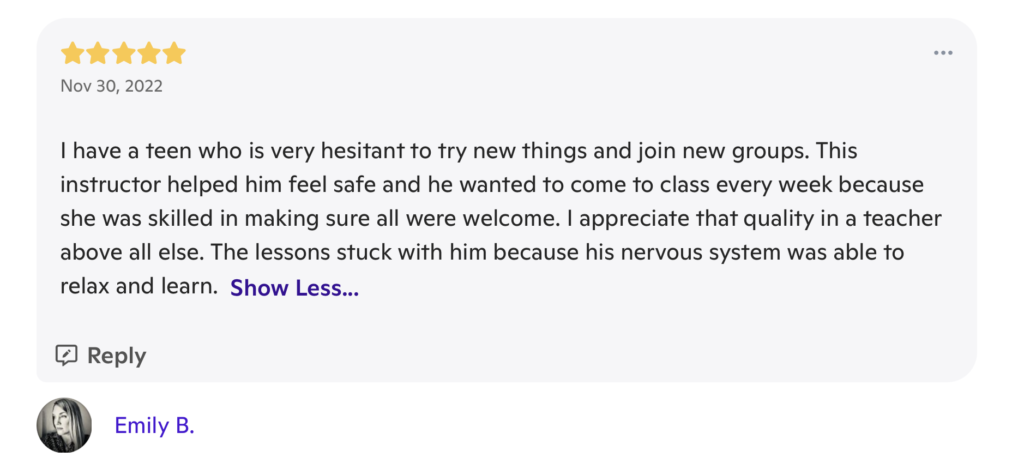
The framework and techniques I present aren’t exclusive to Autistic and neurodivergent brains, so if my approach resonates with you, and you’re fine spending time with Autistic adults, feel free to sign up, even if you’re not Autistic (or aren’t sure).
I want to be realistic, so the honest answer is no. And I wouldn’t trust any short course that makes that promise.
Your anxiety probably developed gradually over a long period of time, likely several years or decades. And it’s had a lot of practice doing this thing that it’s doing (trying to protect you in the only way it knows how).
A few weeks isn’t going to change all of that. But it can make a start. Or add on to what you’re already doing.
I’d like to offer a way to think about anxiety that doesn’t blame or shame you, that doesn’t assume you’re broken or that something’s wrong with you for having anxiety, or for the impact it’s had on your life.
There are enough techniques, of a wide enough variety, that you can pick and choose those that work best for you. If you find even one or two that are helpful, and use them even inconsistently, it can make a big difference over time.
And provide evidence that it can get better!
I'd like to offer a way to think about anxiety that doesn't blame or shame you, that doesn't assume you're broken or that something's wrong with you for having anxiety, or for the impact it's had on your life.
Ugh, I hate that!
I got that advice so much, and found it so unhelpful at my lowest points that, for a long time, someone telling me to relax was actually triggering. Ironic, huh?
To be honest, now that I’ve worked through enough of this process, I do find deep breathing calming, but only after I had access to a fair amount of useful interoception.
Because holding your breath is a common automatic response to pain (mental or physical), I will occasionally offer a reminder to breathe while doing other things, but those other things are the primary exercise, not the breathing.
So no, that’s not directly part of the course.
The techniques presented here are largely based on the work of Steven Hayes PhD, who developed ACT (Acceptance and Commitment Therapy), and Martha Beck PhD, who developed the Wayfinder coaching model.
I’ve modified and adapted their work based on my own life experience and several years as a professional coach working with hundreds of neurodivergent adults and teenagers.
I’ve kept what works, left the rest, and added my own twists, tricks, and style when they’ve worked better.
This is an inclusive, trauma-sensitive, and BS-free zone. ALL are welcome, including cis, trans, nonbinary, a-gender, gender expansive, and other LGBTQIA+ humans.
The live meetings will be conducted via Zoom Meeting. You are welcome to participate with camera off or on, to listen quietly or communicate via chat or voice, to fidget, move, stimm, tic, doodle, take notes, or look away throughout.
Live automatic captions will be available.
You may turn the chat, self-view, and captions off or on as you like.
For executive function help, meeting reminders will be emailed at T -1 day, -3 hrs, and -1 hr.
You may submit questions in advance to be answered during the live meetings, in case you cannot, or do not want to, attend live.
Recordings, transcripts, and the chat log of all live meetings will be available a day or two after the meeting.
You’re welcome to request other accommodations as needed.
This will redirect you to the course platform, Sutra.co.
You’re getting a revamped and upgraded adult version, but this will give you an idea of my ability to deliver on my claims.
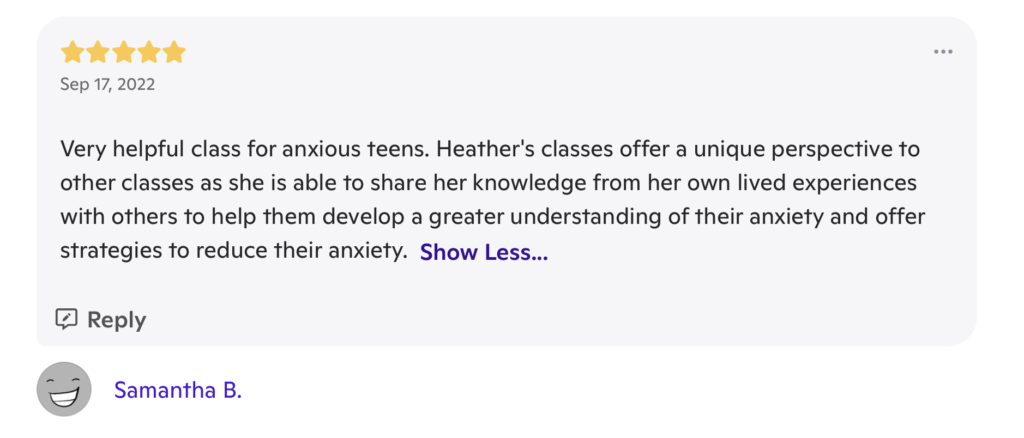
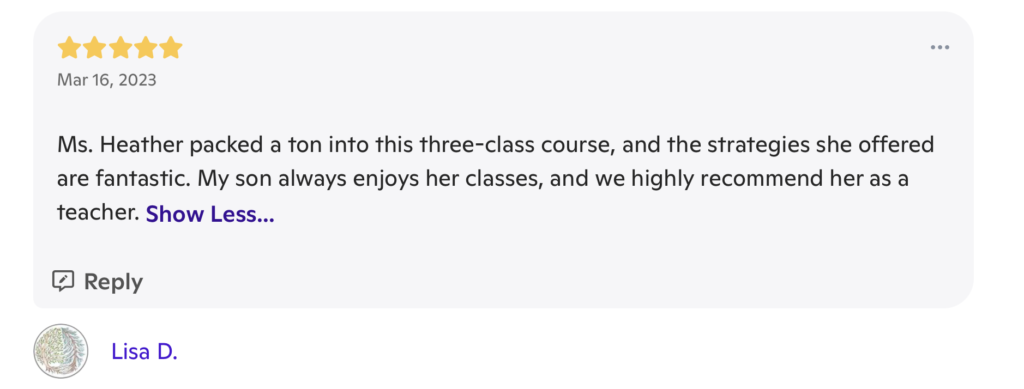

For some people, asking “How Was Your Day?” is a low stress way to start a conversation, so I’d like to talk about some low stress ways to respond.

Meltdowns are no fun, but it is possible to avoid them. Here’s a framework for how.

Why is it that strategies to fix the obvious challenges often don’t work? It’s usually because they don’t get at what’s really going on beneath the surface.
We don’t spam or sell. Promise. Unsubscribe at any time.
Read our privacy policy here.
The information on this site is not intended or implied to be a substitute for psychotherapy, medical advice, diagnosis, or treatment.
© 2020-2024 Autism Chrysalis LLC.